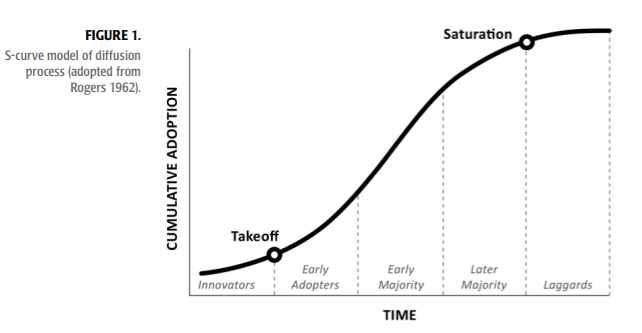For most people, it seems as though artificial intelligence has suddenly emerged as an idea and set of possibilities. In truth, AI has been gestating for many many decades. But forms of AI already are used in consumer appliances such as smart speakers, recommendation engines and search functions.
What seems to be happening now is some inflection point in adoption. But consider the explosion of interest in large language models or generative AI. Development has been under way for more than 70 years.

source: Black Hawk College
“Most people overestimate what they can achieve in a year and underestimate what they can achieve in ten years” is a quote whose provenance is unknown, though some attribute it to Standord computer scientist Roy Amara. Some people call it the “Gate’s Law.”
The principle is useful for technology market forecasters, as it seems to illustrate other theorems including the S curve of product adoption. The expectation for virtually all technology forecasts is that actual adoption tends to resemble an S curve, with slow adoption at first, then eventually rapid adoption by users and finally market saturation.
That sigmoid curve describes product life cycles, suggests how business strategy changes depending on where on any single S curve a product happens to be, and has implications for innovation and start-up strategy as well.

source: Semantic Scholar
Some say S curves explain overall market development, customer adoption, product usage by individual customers, sales productivity, developer productivity and sometimes investor interest. It often is used to describe adoption rates of new services and technologies, including the notion of non-linear change rates and inflection points in the adoption of consumer products and technologies.
In mathematics, the S curve is a sigmoid function. It is the basis for the Gompertz function which can be used to predict new technology adoption and is related to the Bass Model.
Another key observation is that some products or technologies can take decades to reach mass adoption.
It also can take decades before a successful innovation actually reaches commercialization. The next big thing will have first been talked about roughly 30 years ago, says technologist Greg Satell. IBM coined the term machine learning in 1959, for example, and machine learning is only now in use.
Many times, reaping the full benefits of a major new technology can take 20 to 30 years. Alexander Fleming discovered penicillin in 1928, it didn’t arrive on the market until 1945, nearly 20 years later.
Electricity did not have a measurable impact on the economy until the early 1920s, 40 years after Edison’s plant, it can be argued.
It wasn’t until the late 1990’s, or about 30 years after 1968, that computers had a measurable effect on the US economy, many would note.

source: Wikipedia
The S curve is related to the product life cycle, as well.
Another key principle is that successive product S curves are the pattern. A firm or an industry has to begin work on the next generation of products while existing products are still near peak levels.

source: Strategic Thinker
There are other useful predictions one can make when using S curves. Suppliers in new markets often want to know “when” an innovation will “cross the chasm” and be adopted by the mass market. The S curve helps there as well.
Innovations reach an adoption inflection point at around 10 percent. For those of you familiar with the notion of “crossing the chasm,” the inflection point happens when “early adopters” drive the market. The chasm is crossed at perhaps 15 percent of persons, according to technology theorist Geoffrey Moore.

source
For most consumer technology products, the chasm gets crossed at about 10 percent household adoption. Professor Geoffrey Moore does not use a household definition, but focuses on individuals.

source: Medium
And that is why the saying “most people overestimate what they can achieve in a year and underestimate what they can achieve in ten years” is so relevant for technology products. Linear demand is not the pattern.
One has to assume some form of exponential or non-linear growth. And we tend to underestimate the gestation time required for some innovations, such as machine learning or artificial intelligence.
Other processes, such as computing power, bandwidth prices or end user bandwidth consumption, are more linear. But the impact of those linear functions also tends to be non-linear.
Each deployed use case, capability or function creates a greater surface for additional innovations. Futurist Ray Kurzweil called this the law of accelerating returns. Rates of change are not linear because positive feedback loops exist.

source: Ray Kurzweil
Each innovation leads to further innovations and the cumulative effect is exponential.
Think about ecosystems and network effects. Each new applied innovation becomes a new participant in an ecosystem. And as the number of participants grows, so do the possible interconnections between the discrete nodes. 
source: Linked Stars Blog
Think of that as analogous to the way people can use one particular innovation to create another adjacent innovation. When A exists, then B can be created. When A and B exist, then C and D and E and F are possible, as existing things become the basis for creating yet other new things.
So we often find that progress is slower than we expect, at first. But later, change seems much faster. And that is because non-linear change is the norm for technology products.